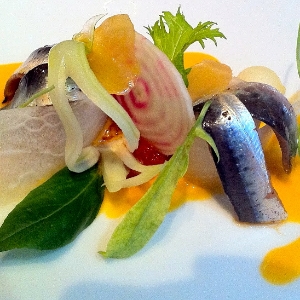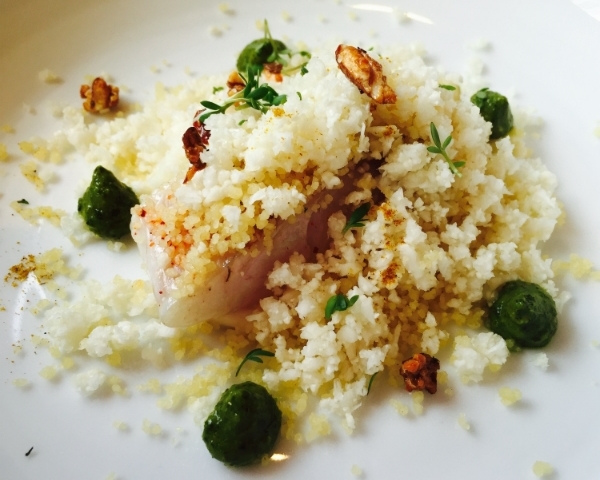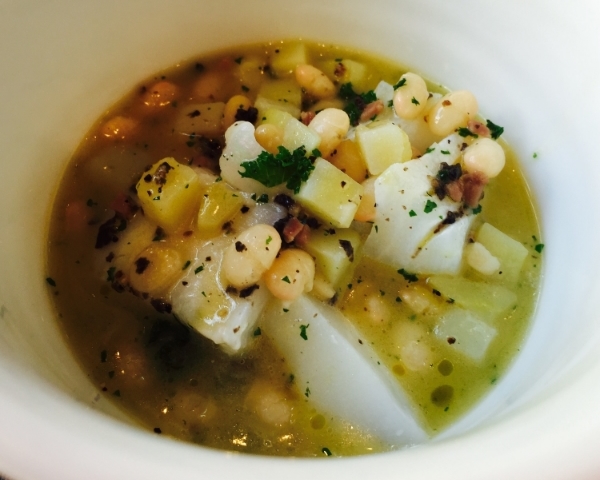Fried clams, corn, cream, marinated peppers, basil
Braden Perkins the immensely creative chef behind Palais Royal restaurant Verjus, and the adjacent Verjus wine bar, is going for a third win with his latest tapas-style endeavor, Ellsworth (a tribute to Perkins’s Grandfather). Perkins has installed 22 year old Canadian Hannah Kowalenko as head chef, who adds a brand of inventiveness beyond her years to Perkins’s already impressive repertoire.
The evening menu, which offers nearly a dozen substantive little tastes, a cheese selection and two desserts to choose from, is perfect for a quick snack or a multi-course feast, depending upon one’s appetite of the moment. The food is generally full of bright, vibrant flavors, well-seasoned (although at times a little heavy handed with the salt), and cleverly conceived, with no theme that screams “you’ve seen this all before too many times.” Most dishes are priced at 10 to 13€, each copious enough for two to share.
The long, narrow dining room, with plenty of bright window space, is sober but not cold, with light wooden floors, crisp white walls, 1930s style bistro chairs, antique brass wall sconces, and slate grey banquettes. The small white marble tables, white linen napkins (thank you!), and beautifully engraved Ellsworth wine glasses give the place a touch of class, freshness, and modernity.
As if Kowalenko had been given a list of my personal preferences, I happily discovered the seasonal menu (which changes regularly according to market offerings) replete with some of my current favorite ingredients and dishes: seasonal corn, green beans, pork meatballs, deep-fried clams and grilled squid. Each dish has a personal signature and when a dish sings it does so loud and clear. My favorites were the fried clams (palourdes) set on a bed of fresh corn kernels bathed in a light creamed corn soup, a touch of basil, and a few slices of marinated baby peppers. The clams were heavily breaded and fried to a perfect golden crunch, with the sweet corn serving as fresh, lively foil.
I loved, as well, the fresh green beans and pencil-thin baby carrots that were seriously wok-style sautéed over high heat, giving them a smoky, meaty personality. She is clever with flavor pairings and pays close attention to how texture plays in a dish. Here the smoky vegetables were set against a bed of mild creamy houmous, a touch of sesame, and covered with a shower of deliciously crunchy bread crumbs, a combination that awakened one’s palate and could almost have been a meal in itself.
The least interesting dish of the meal was the homemade mozzarella, thin as lasagna, wrapped like Vietnamese rice paper around a very good blend of tiny cubes of sautéed tomatoes and zucchini, seasoned with herbs and capers. While the filling was truly satisfying, the mozzarella itself lacked flavor and substance, and left me wondering why bother making such things in-house when the results are so underwhelming. The dish’s visual appeal cannot be denied though.
The baby squid was decisively seared to a smoky high and was set on a bed of timidly seasoned riced potatoes and leeks – good but I would have preferred a bolder pairing. One of my favorite dishes of the meal – the beautifully seasoned and well-seared pork meatballs – were sadly marred by an unforgivably harsh harissa.
Desserts were winners, with a very moist and intense walnut cake topped with a colorful, generous, full-flavored blend of seasonal fruits – cubed peaches, nectarines, blueberries and giant blackberries just slightly warm – finished with dulche de leche, a dollop of cream and bits of crunchy, crumbled walnuts (photo below). The pairing of malt ice cream and chocolate sorbet was brilliant and quite irresistible, even after the marathon sampling of little plates.
I’ll go back for sure, as this meal rates among the most inspired I have had in many months, and I am keen to follow the culinary adventures of both Perkins and Kowalenko through the seasons.
At lunch time there is a set, fixed price menu, with a trio of choices at each course. The wine list offers a good selection of sips by the glass, and service is swift and pleasant.
Ellsworth | 34 rue de Richelieu | Paris 1 | +33 142 60 59 66 | Métro: Pyramides or Palais Royal-Musée du Louvre | Fixed price lunch menu 18-24€, Sunday brunch à la carte 8-15€ per plate, dinner small plates menu 10-13€ | www.ellsworthparis.com | ellsworthparis@gmail.com
For more Paris restaurant reviews, get The Food Lover's Guide to Paris 5th edition or download the app.
















